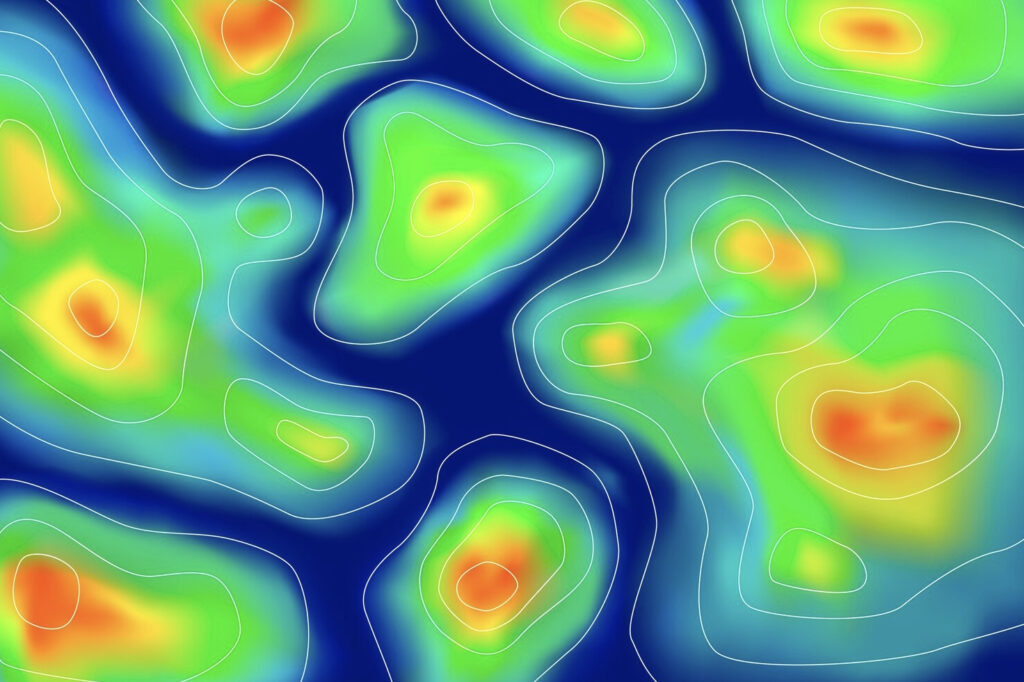In PPC (pay-per-click) advertising, every click costs. This makes maximizing the effectiveness of each landing page crucial to a successful campaign. One of the most effective yet underutilized methods for enhancing landing page performance is through heatmap tools for PPC. Heatmaps offer visual insights into how visitors interact with a page, revealing precisely where users click, scroll, and spend time.
Understanding these behaviors on PPC landing pages can significantly improve conversion rates. By analyzing user actions through heatmaps, marketers can identify what works and what doesn’t, ensuring that important elements like CTAs, forms, and essential content are visible and engaging. This guide delves into the power of heatmaps, exploring how to use them effectively in PPC landing page optimization to increase conversions and get the most out of each ad dollar.
What Is a Heatmap?
A heatmap is a visual tool that displays data using colors to show the intensity of user actions on a webpage. Heatmap tools for PPC campaigns help marketers understand where visitors focus their attention on a landing page, allowing for adjustments that enhance usability and drive conversions. There are several types of heatmaps, each providing unique insights:
Types of Heatmaps
- Click Heatmaps:
Click heatmaps show where users click most frequently on a page. This helps identify which elements attract attention and which might need repositioning. For example, if users aren’t clicking on a CTA, it may be because it’s poorly placed or not prominent enough. - Scroll Heatmaps:
Scroll heatmaps display how far down a page users scroll. This insight is invaluable in understanding whether visitors see the essential content. If crucial information is placed too far down the page, users may leave before reaching it. In PPC landing pages, where every element should support the conversion goal, ensuring that users see essential content is paramount. - Move Heatmaps:
Move heatmaps track where users move their mouse, revealing which areas capture their interest. This is useful for identifying sections that may need further optimization, such as adjusting content placement or visual hierarchy.
Each heatmap type has its role in building a detailed understanding of user behavior. Together, they allow PPC marketers to optimize landing pages, ensuring users engage with key content and are more likely to convert.
Benefits of Using Heatmaps for PPC Landing Page Optimization
Incorporating heatmap analysis into PPC landing page optimization offers several strategic benefits that directly impact campaign success:
- Enhanced Understanding of User Behavior
Heatmap tools for PPC provide direct insight into how visitors engage with a page, enabling marketers to see whether specific elements capture attention. If users are ignoring critical CTAs or are distracted by non-essential elements, this data can guide necessary adjustments. Understanding user engagement also helps identify design elements that may need refinement for better results. - Improved Conversion Rates
By pinpointing exactly where users click, scroll, or hover, heatmaps make it easier to make design adjustments that can boost conversions. For example, if a CTA button isn’t getting attention, changing its placement or style can make it more visible. These small changes have a cumulative effect, leading to a higher conversion rate over time and ultimately a more profitable PPC campaign. - Reduced Bounce Rates
Bounce rates are a common challenge in PPC campaigns, as visitors might quickly leave a landing page if it doesn’t immediately capture their interest. Heatmaps can highlight friction points that drive users away, such as cluttered layouts or poorly placed CTAs. By addressing these issues, you reduce bounce rates, encouraging visitors to stay on the page and engage with the content.
Using heatmaps to understand and optimize PPC landing pages creates a more engaging user experience, which ultimately helps reduce wasted ad spend and boosts ROI.
How Heatmaps Improve PPC Campaigns
Heatmaps provide actionable insights that can significantly enhance the performance of PPC campaigns. Here’s how they contribute to better results:
- Highlighting Top-Performing Areas
Heatmaps can reveal which areas of the landing page attract the most attention. Knowing where users naturally focus helps ensure that the most critical information—like offers, CTAs, or product highlights—is positioned strategically. For example, if users focus more on images than text, placing an eye-catching CTA next to the image may increase conversions. - Identifying Underperforming Elements
PPC landing pages need to be streamlined and distraction-free. Heatmaps can reveal if certain elements on the page are ignored or creating confusion. For instance, if a CTA button isn’t receiving enough clicks, it might be due to its color, position, or size. Adjusting these elements based on heatmap data ensures the page guides users toward the intended action. - Optimizing Page Length and Content
With scroll heatmaps, you can see how far down the page visitors scroll, helping to determine if content is too lengthy or overwhelming. If most users don’t reach the bottom of the page, consider restructuring content or moving important elements higher up. For PPC landing pages, concise, impactful content is essential, and heatmaps provide a way to ensure the layout aligns with user expectations.
By incorporating these insights, heatmap tools for PPC campaigns allow marketers to fine-tune each landing page, creating an optimized experience that encourages clicks and conversions.
Best Practices for Analyzing PPC Landing Page Heatmaps
To maximize the value of heatmap analysis, follow these best practices for evaluating PPC landing pages effectively:
- Focus on High-Traffic Pages
Start by analyzing pages with the highest traffic from your PPC campaigns. This prioritization ensures that you’re making the most significant impact with your optimizations. Concentrating on these high-traffic pages can lead to faster, more noticeable improvements in campaign performance. - Review Heatmap Data Regularly
User behavior can shift over time, especially if you update content or launch new PPC ads. Periodic review of heatmap data ensures that your optimizations stay aligned with changing visitor expectations. Regular analysis also helps identify trends, allowing you to make adjustments before small issues affect campaign success. - Combine Heatmaps with Other Analytics Tools
While heatmaps provide a visual representation of user actions, combining this data with other tools, like session recordings or funnel analysis, gives a fuller picture. This complementary approach enables you to understand both where users focus their attention and why they take certain actions.
By following these best practices, you ensure that heatmap tools for PPC are used to their fullest potential, helping to refine landing pages in ways that directly support your conversion goals.
Choosing the Right Heatmap Tools for PPC
There are various heatmap tools available, each offering unique features for analyzing PPC landing pages. Here are some top options:
- Hotjar
Hotjar offers click, scroll, and move heatmaps, along with session recordings, making it a comprehensive tool for understanding user journeys. Hotjar is especially useful for gaining insights into how visitors engage with different parts of your landing page. - Crazy Egg
Known for its user-friendly interface, Crazy Egg provides click and scroll heatmaps, along with A/B testing options. This makes it easy to experiment with different page elements and layouts to see which versions drive higher engagement and conversions on PPC landing pages. - Mouseflow
In addition to heatmaps, Mouseflow includes session replays and funnel analysis, which helps identify bottlenecks in the user journey. This tool is beneficial for tracking the complete user path, enabling you to understand where visitors might drop off or encounter issues.
Selecting the right heatmap tool depends on your specific PPC goals, the type of analysis you need, and your budget. The right choice will help you optimize landing pages more effectively, directly contributing to a higher ROI.
Conclusion: Integrating Heatmaps into Your PPC Strategy
Using heatmap tools for PPC landing pages is a powerful way to understand and improve user behavior on your site. Heatmaps offer data-driven insights into how users interact with each element, helping to refine layouts, improve CTA placement, and enhance the overall user experience. These adjustments ensure that your PPC landing pages are optimized for conversions, allowing you to get the most out of each click and reduce wasted ad spend.
By consistently analyzing heatmap data and implementing changes, you can develop a dynamic PPC strategy that adapts to user needs, resulting in more conversions and a stronger ROI. Integrating heatmaps into your PPC optimization process empowers you with a clear view of user engagement, setting you on the path to campaign success.


